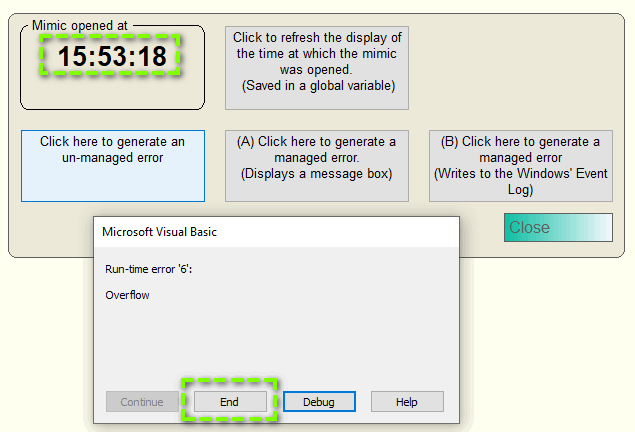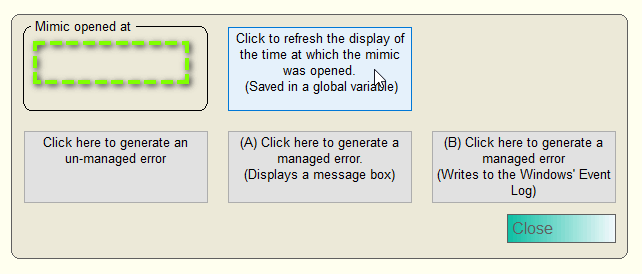| Applies to:
PcVue version 8.2 SP1. |
|
|
|
|
| Summary:If there is a VBA error, and you have a runtime licence, the VBA error message dialog is supressed. Why? Because this dialog has a Debug button that would allow the User access to the VBA environment. Instead the VBA module is automatically reset (equivalent to clicking the End button) which clears the value of any global variables.
You can see the problem in this simple example. When the mimic is opened the time is saved in a global variable and displayed in a text object. If you click the button to generate an un-managed error, the error dialog appears. Click the End button and the module is reset. (Remember – with a runtime license the dialog is not displayed and the module is automatically reset) Of course this is a trivial example – but the global variable could have been for something critical to the operation – a file name for example. This is important to handle potential errors in all of your VBA functions and procedures. Here bellow is a way to do that. |
|
|
|
|
| Details:Create a new module in your VBA project and name it “ErrorHandling”. Add the following function to this module: Public Sub HandleError() Dim ErrNumber As Long Dim ErrDescription As String Dim ErrSource As String Dim ErrFilePath As String Dim ErrFileName As String Dim ErrLogFileName As String Dim ErrLogFile As Integer ErrNumber = Err.Number ErrDescription = Err.Description ErrSource = Err.Source ErrFilePath = Environ(“TEMP”) ErrFileName = “VBA_Error_Log_” & Format(Date, “YYYYMMDD”) & “.log” ErrLogFileName = ErrFilePath & “\” & ErrFileName ErrLogFile = FreeFile Open ErrLogFileName For Append As #ErrLogFile Print #ErrLogFile, “Date: ” & Format(Now, “YYYY/MM/DD HH:MM:SS”) Print #ErrLogFile, “Error Number: ” & ErrNumber Print #ErrLogFile, “Error Description: ” & ErrDescription Print #ErrLogFile, “Error Source: ” & ErrSource Print #ErrLogFile, “” Close #ErrLogFile ‘MsgBox “An error has occurred. Please check the error log at ” & ErrLogFileName, vbCritical, “Error” ‘To display a message box (Warning, this is a modal view and all VBA is blocked until you close it) ‘Debug.Print “An error has occurred. Please check the error log at ” & ErrLogFileName ‘ To display the message in immediate window (Ctrl + G) Debug.Print “Date: ” & Format(Now, “YYYY/MM/DD HH:MM:SS”) & “. Error Number: ” & ErrNumber & “. Error Description: ” & ErrDescription & “. Error Source: ” & ErrSource & “. Saved in ” & ErrLogFileName ‘ To display the message in immediate window (Ctrl + G) End Sub In each function of your code, add the “On Error” statement as follows: Function YourFunctionName() On Error GoTo ErrorHandler ‘Code de votre fonction ici On Error GoTo 0 Exit Function ErrorHandler: Call HandleError Exit Function End Function In each sub-procedure of your code, add the “On Error” statement as follows: Sub YourSubroutineName() On Error GoTo ErrorHandler ‘Code de votre sous-procédure ici On Error GoTo 0 Exit Sub ErrorHandler: Call HandleError Exit Sub End Sub The “On Error GoTo ErrorHandler” statement allows you to redirect the control to an ErrorHandler label in case of an error. In this label, you can call the HandleError function to record the error details in the log file and display an error message to the user. |
|
|
|
|
|
|
Created on: 11 Feb 2011 Last update: 26 Aug 2024

